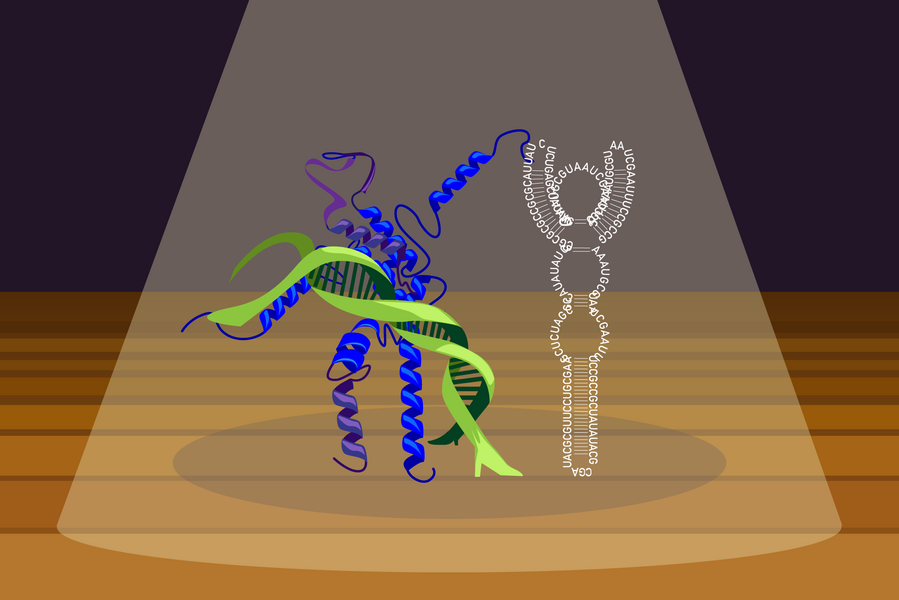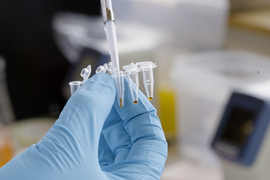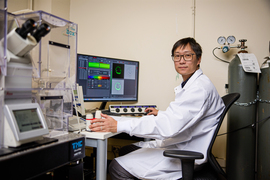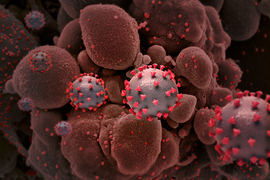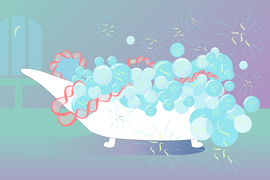Transcription factors could be the Swiss Army knives of gene regulation; they are versatile proteins containing multiple specialized regions. On one end they have a region that can bind to DNA. On the other end they have a region that can bind to proteins. Transcription factors help to regulate gene expression — turning genes on or off and dialing up or down their level of activity — often in partnership with the proteins that they bind. They anchor themselves and their partner proteins to DNA at binding sites in genetic regulatory sequences, bringing together the components that are needed to make gene expression happen.
Transcription factors are a well-known family of proteins, but new research from MIT professor of biology and Whitehead Institute for Biomedical Research member Richard Young and colleagues shows that the picture we have had of them is incomplete. In a paper published in Molecular Cell on July 3, Young and Whitehead Institute postdocs Ozgur Oksuz and Jonathan Henninger reveal that along with DNA and protein, many transcription factors can also bind RNA. The researchers found that RNA binding keeps transcription factors near their DNA binding sites for longer, helping to fine-tune gene expression. This rethinking of how transcription factors work may lead to a better understanding of gene regulation, and may provide new targets for RNA-based therapeutics.
“It’s as if, after carrying around a Swiss Army knife all your life for its blade and scissors, you suddenly realize that the odd, small piece in the back of the knife is a screwdriver,” says Young. “It’s been staring you in the face this whole time, and now that you finally see it, it becomes clear how many more uses there are for the knife than you had realized.”
How transcription factors’ RNA binding went overlooked
A few papers, including one from Young’s lab, had previously identified individual transcription factors as being able to bind RNA, but researchers thought that this was a quirk of the specific transcription factors. Instead, Young, Oksuz, Henninger and collaborators have shown that RNA-binding is in fact a common feature present in at least half of transcription factors.
“We show that RNA binding by transcription factors is a general phenomenon,” Oksuz says. “Individual examples in the past were thought to be exceptions to the rule. Other studies dismissed signs of RNA binding in transcription factors as an artifact — an accident of the experiment rather than a real finding. The clues have been there all along, but I think earlier work was so focused on the DNA and protein interactions that they didn’t consider RNA.”
The reason that researchers had not recognized transcription factors’ RNA binding region as such is because it is not a typical RNA binding domain. Typical RNA binding domains form stable structures that researchers can detect or predict with current technologies. Transcription factors do not contain such structures, and so standard searches for RNA binding domains had not identified them in transcription factors.
Young, Oksuz, and Henninger got their biggest clue that researchers might be overlooking something from the human immunodeficiency virus (HIV), which produces a transcription factor-like protein called Tat. Tat increases the transcription of HIV’s RNA genome by binding to the virus’s RNA and then recruiting cellular machinery to it. However, Tat does not contain a structured RNA binding site; instead, it binds RNA from a region called an arginine-rich motif (ARM) that is unstructured but has a high affinity for RNA. When the ARM binds to HIV RNA, the two molecules form a more stable structure together.
The researchers wondered if Tat might be more similar to human transcription factors than anyone had realized. They went through the list of transcription factors, and instead of looking for structured RNA binding domains, they looked for ARMs. They found them in abundance; the majority of human transcription factors contain an ARM-like region between their DNA and protein binding regions, and these sequences were conserved across animal species. Further testing confirmed that many transcription factors do in fact use their ARMs to bind RNA.
RNA binding fine-tunes gene expression
Next, the researchers tested to see if RNA binding affected the transcription factors’ function. When transcription factors had their ARMs mutated so they couldn’t bind RNA, those transcription factors were less effective in finding their target sites, remaining at those sites, and regulating genes. The mutations did not prevent transcription factors from functioning altogether, suggesting that RNA binding contributes to fine-tuning of gene regulation.
Further experiments confirmed the importance of RNA binding to transcription factor function. The researchers mutated the ARM of a transcription factor important to embryonic development, and found that this led to developmental defects in zebra fish. Additionally, they looked through a list of genetic mutations known to contribute to cancer and heritable diseases, and found that a number of these occur in the RNA binding regions of transcription factors. All of these findings point to RNA binding playing an important role in transcription factors’ regulation of gene expression.
They may also provide therapeutic opportunities. The transcription factors studied by the researchers were found to bind RNA molecules that are produced in the regulatory regions of the genome where the transcription factors bind DNA. This set of transcription factors includes factors that can increase or decrease gene expression. “With evidence that RNAs can tune gene expression through their interaction with positive and negative transcription factors,” says Henninger, “we can envision using existing RNA-based technologies to target RNA molecules, potentially increasing or decreasing expression of specific genes in disease settings.”
